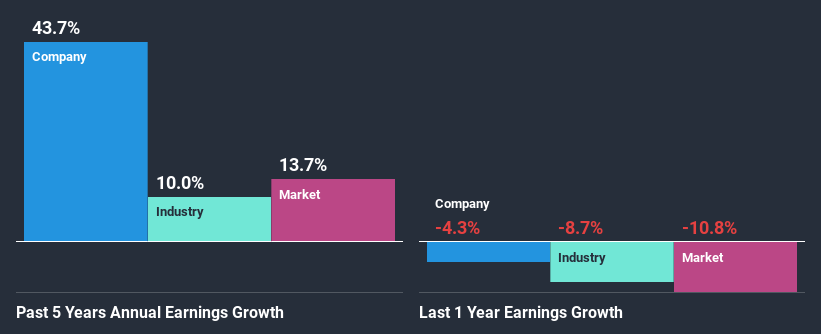- India
- /
- Basic Materials
- /
- NSEI:HEIDELBERG
Is HeidelbergCement India Limited's (NSE:HEIDELBERG) Stock's Recent Performance A Reflection Of Its Financial Health?

HeidelbergCement India's (NSE:HEIDELBERG) stock is up by 8.6% over the past three months. Since the market usually pay for a company’s long-term financial health, we decided to study the company’s fundamentals to see if they could be influencing the market. Particularly, we will be paying attention to HeidelbergCement India's ROE today.
ROE or return on equity is a useful tool to assess how effectively a company can generate returns on the investment it received from its shareholders. In other words, it is a profitability ratio which measures the rate of return on the capital provided by the company's shareholders.
Check out our latest analysis for HeidelbergCement India
How Is ROE Calculated?
The formula for ROE is:
Return on Equity = Net Profit (from continuing operations) ÷ Shareholders' Equity
So, based on the above formula, the ROE for HeidelbergCement India is:
18% = ₹2.4b ÷ ₹13b (Based on the trailing twelve months to June 2020).
The 'return' is the profit over the last twelve months. One way to conceptualize this is that for each ₹1 of shareholders' capital it has, the company made ₹0.18 in profit.
What Is The Relationship Between ROE And Earnings Growth?
We have already established that ROE serves as an efficient profit-generating gauge for a company's future earnings. Based on how much of its profits the company chooses to reinvest or "retain", we are then able to evaluate a company's future ability to generate profits. Assuming all else is equal, companies that have both a higher return on equity and higher profit retention are usually the ones that have a higher growth rate when compared to companies that don't have the same features.
HeidelbergCement India's Earnings Growth And 18% ROE
To start with, HeidelbergCement India's ROE looks acceptable. Especially when compared to the industry average of 9.0% the company's ROE looks pretty impressive. Probably as a result of this, HeidelbergCement India was able to see an impressive net income growth of 44% over the last five years. We reckon that there could also be other factors at play here. For instance, the company has a low payout ratio or is being managed efficiently.
As a next step, we compared HeidelbergCement India's net income growth with the industry, and pleasingly, we found that the growth seen by the company is higher than the average industry growth of 10.0%.

The basis for attaching value to a company is, to a great extent, tied to its earnings growth. The investor should try to establish if the expected growth or decline in earnings, whichever the case may be, is priced in. Doing so will help them establish if the stock's future looks promising or ominous. One good indicator of expected earnings growth is the P/E ratio which determines the price the market is willing to pay for a stock based on its earnings prospects. So, you may want to check if HeidelbergCement India is trading on a high P/E or a low P/E, relative to its industry.
Is HeidelbergCement India Efficiently Re-investing Its Profits?
HeidelbergCement India has a three-year median payout ratio of 41% (where it is retaining 59% of its income) which is not too low or not too high. This suggests that its dividend is well covered, and given the high growth we discussed above, it looks like HeidelbergCement India is reinvesting its earnings efficiently.
Besides, HeidelbergCement India has been paying dividends over a period of three years. This shows that the company is committed to sharing profits with its shareholders.
Summary
On the whole, we feel that HeidelbergCement India's performance has been quite good. Specifically, we like that the company is reinvesting a huge chunk of its profits at a high rate of return. This of course has caused the company to see substantial growth in its earnings. If the company continues to grow its earnings the way it has, that could have a positive impact on its share price given how earnings per share influence long-term share prices. Not to forget, share price outcomes are also dependent on the potential risks a company may face. So it is important for investors to be aware of the risks involved in the business. Our risks dashboard will have the 1 risk we have identified for HeidelbergCement India.
If you decide to trade HeidelbergCement India, use the lowest-cost* platform that is rated #1 Overall by Barron’s, Interactive Brokers. Trade stocks, options, futures, forex, bonds and funds on 135 markets, all from a single integrated account. Promoted
Valuation is complex, but we're here to simplify it.
Discover if HeidelbergCement India might be undervalued or overvalued with our detailed analysis, featuring fair value estimates, potential risks, dividends, insider trades, and its financial condition.
Access Free AnalysisThis article by Simply Wall St is general in nature. It does not constitute a recommendation to buy or sell any stock, and does not take account of your objectives, or your financial situation. We aim to bring you long-term focused analysis driven by fundamental data. Note that our analysis may not factor in the latest price-sensitive company announcements or qualitative material. Simply Wall St has no position in any stocks mentioned.
*Interactive Brokers Rated Lowest Cost Broker by StockBrokers.com Annual Online Review 2020
Have feedback on this article? Concerned about the content? Get in touch with us directly. Alternatively, email editorial-team@simplywallst.com.
About NSEI:HEIDELBERG
HeidelbergCement India
Engages in the manufacture and sale of cement in India.
Flawless balance sheet with moderate growth potential.
Similar Companies
Market Insights
Community Narratives



